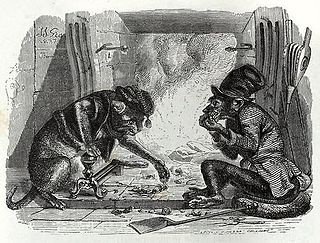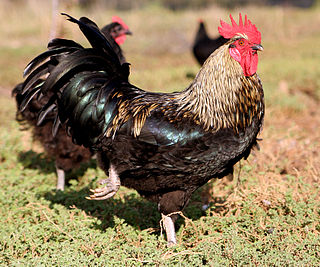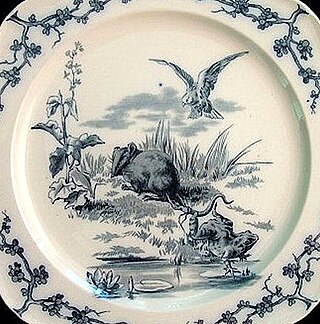
The Frogs and the Sun is one of Aesop's Fables and is numbered 314 in the Perry Index. [1] It has been given political applications since Classical times.

The Frogs and the Sun is one of Aesop's Fables and is numbered 314 in the Perry Index. [1] It has been given political applications since Classical times.
There are both Greek and Latin versions of the fable. Babrius tells it unadorned and leaves hearers to draw their own conclusion, but Phaedrus gives the story a context. While people are rejoicing at the wedding of a thief, Aesop tells a story of frogs who lament at the marriage of the sun. This would mean the birth of a second sun and the frogs suffer already from the drying up of the ponds and marshes in which they live.
Though the story appears to have an ecological meaning, it was believed that the real target was Sejanus, the powerful aide of the Roman Emperor Tiberius, who had attempted to marry into the imperial family. [2] Certainly the fable was used in a similar way to criticize overweening lords during the Middle Ages. Marie de France's Ysopet contains a version of the story which was to influence later writers. In her telling, the Sun asks the animals for advice on taking a partner. Alarmed, they appeal to Destiny on the grounds that nothing would be able to grow in the heat of a second sun. Marie draws the feudal lesson in a moralising passage at the end. [3]
The fable was included in Nicholas Bozon's collection of moralising stories (Contes moralisés) during the 1320s. Prefaced with a Latin comment that great lords impoverish others, it pictures the Sun asking his courtiers to find him a rich wife. They take the problem to Destiny, who points out the danger that would follow from having a second sun. [4] A century later, John Lydgate tells the story of "The Sun’s Marriage" in his Isopes Fabules. Here it is prefaced by an attack on tyranny, which the story is to illustrate. The Sun asks the assembly of gods for advice on taking a marriage partner and they disallow such a union. [5]
William Caxton's account later in the 14th century is nearer the Phaedrus version. It is prefaced by the remark that 'of an evil man may well issue a worse than himself' and then relates the circumstances in which Aesop tells the tale. It is ‘all the nations of the world’ who appeal to Jupiter against the proposed marriage, realising for themselves the calamity that would follow from having more than one sun. [6] The story went on to be included by Jean de la Fontaine in his first collection of fables (1668), where it is told as a cautionary tale at a tyrant's wedding. [7]
Contemporary politics, however, were soon to give the fable an alternative reading, supporting the sovereign powers against the upstart, commercially successful Dutch Republic. The first to do so was the royalist John Ogilby, adding the fable to his 1665 edition, coupled with an illustration by Wenceslas Hollar of frogs demonstrating against the background of the Amsterdam Town Hall. According to this interpretation, the Republic was ungratefully throwing over its former ally who (in its own view, at least) had helped the Dutch to prosperity. The poem was also issued as a propaganda pamphlet under the title of The Frog, or the Low Countrey Nightingale during the Second Anglo-Dutch War.
A similar claim was made, using the same fable, during the Franco-Dutch War of 1672-8 in a European pamphlet war encompassing publications in Latin, French, Spanish and Italian. [8] La Fontaine's contribution was a long fable with the same title (Le soleil et les grenouilles), dating from this time but not included among his fables until the final volume. The (Dutch) frogs, having spread to every shore, are now complaining of the tyranny of the Solar Monarch (Louis XIV). The poem ends with a threat of the vengeance that the Sun will soon bring upon the impudence of ‘That kingless, half-aquatic crew’. [9]
Steering clear of this international context, Edmé Boursault adapted the fable's story line but substituted other characters in his play from this period, Les Fables d'Ésope (1690). Meeting a father who boasts of the professions of his many sons, Ésope satirises the burden of an expensive civil service by relating the story of “Les colombes et le vautour”. There the doves deplore the vulture's projected wedding as a threat to their continued existence, as in the fable of the frogs, but the political situation is widened to that of The Kite and the Doves. [10]
Thereafter the subverted fable dropped from popularity until it was revived, in both France and Britain, during the 19th century. The La Fontaine version also served as the basis for one of Ned Rorem’s micro-operas in 1971. [11]

Gaius Julius Phaedrus, or Phaeder was a 1st-century AD Roman fabulist and the first versifier of a collection of Aesop's fables into Latin. Nothing is recorded of his life except for what can be inferred from his poems, and there was little mention of his work during late antiquity. It was not until the discovery of a few imperfect manuscripts during and following the Renaissance that his importance emerged, both as an author and in the transmission of the fables.

Aesop's Fables, or the Aesopica, is a collection of fables credited to Aesop, a slave and storyteller who lived in ancient Greece between 620 and 564 BCE. Of varied and unclear origins, the stories associated with his name have descended to modern times through a number of sources and continue to be reinterpreted in different verbal registers and in popular as well as artistic media.

The Frog and the Ox appears among Aesop's Fables and is numbered 376 in the Perry Index. The story concerns a frog that tries to inflate itself to the size of an ox, but bursts in the attempt. It has usually been applied to socio-economic relations.

The Monkey and the Cat is best known as a fable adapted by Jean de La Fontaine under the title Le Singe et le Chat that appeared in the second collection of his Fables in 1679 (IX.17). It is the source of popular idioms in both English and French, with the general meaning of being the dupe of another.
The Frogs Who Desired a King is one of Aesop's Fables and numbered 44 in the Perry Index. Throughout its history, the story has been given a political application.

The Dog and Its Reflection is one of Aesop's Fables and is numbered 133 in the Perry Index. The Greek language original was retold in Latin and in this way was spread across Europe, teaching the lesson to be contented with what one has and not to relinquish substance for shadow. There also exist Indian variants of the story. The morals at the end of the fable have provided both English and French with proverbs and the story has been applied to a variety of social situations.
The Cat and the Mice is a fable attributed to Aesop of which there are several variants. Sometimes a weasel is the predator; the prey can also be rats and chickens.

Belling the Cat is a fable also known under the titles The Bell and the Cat and The Mice in Council. In the story, a group of mice agree to attach a bell to a cat's neck to warn of its approach in the future, but they fail to find a volunteer to perform the job. The term has become an idiom describing a group of persons, each agreeing to perform an impossibly difficult task under the misapprehension that someone else will be chosen to run the risks and endure the hardship of actual accomplishment.

The Fox and the Crow is one of Aesop's Fables, numbered 124 in the Perry Index. There are early Latin and Greek versions and the fable may even have been portrayed on an ancient Greek vase. The story is used as a warning against listening to flattery.

The Cock and the Jewel is a fable attributed to Aesop and is numbered 503 in the Perry Index. As a trope in literature, the fable is reminiscent of stories used in Zen such as the kōan. It presents, in effect, a riddle on relative values and is capable of different interpretations, depending on the point of view from which it is regarded.

The Wolf and the Crane is a fable attributed to Aesop that has several eastern analogues. Similar stories have a lion instead of a wolf, and a stork, heron or partridge takes the place of the crane.

The Wolf and the Lamb is a well-known fable of Aesop and is numbered 155 in the Perry Index. There are several variant stories of tyrannical injustice in which a victim is falsely accused and killed despite a reasonable defence.

The Mountain in Labour is one of Aesop's Fables and appears as number 520 in the Perry Index. The story became proverbial in Classical times and was applied to a variety of situations. It refers to speech acts which promise much but deliver little, especially in literary and political contexts. In more modern times the satirical intention behind the fable was given greater emphasis following Jean de la Fontaine's interpretation of it. Illustrations to the text underlined its ironical application particularly and went on to influence cartoons referring to the fable elsewhere in Europe and America.

The miller, his son and the donkey is a widely dispersed fable, number 721 in the Perry Index and number 1215 in the Aarne–Thompson classification systems of folklore narratives. Though it may have ancient analogues, the earliest extant version is in the work of the 13th-century Arab writer Ibn Said. There are many eastern versions of the tale and in Europe it was included in a number of Mediaeval collections. Since then it has been frequently included in collections of Aesop's fables as well as the influential Fables of Jean de la Fontaine.

The Man with Two Mistresses is one of Aesop's Fables that deals directly with human foibles. It is numbered 31 in the Perry Index.
The Fox and the Woodman is a cautionary story against hypocrisy included among Aesop's Fables and is numbered 22 in the Perry Index. Although the same basic plot recurs, different versions have included a variety of participants.

The Ass and his Masters is a fable that has also gone by the alternative titles The ass and the gardener and Jupiter and the ass. Included among Aesop's Fables, it is numbered 179 in the Perry Index.

The Frog and the Mouse is one of Aesop's Fables and exists in several versions. It is numbered 384 in the Perry Index. There are also Eastern versions of uncertain origin which are classified as Aarne-Thompson type 278, concerning unnatural relationships. The stories make the point that the treacherous are destroyed by their own actions.

The Eagle and the Fox is a fable of friendship betrayed and avenged. Counted as one of Aesop’s Fables, it is numbered 1 in the Perry Index. The central situation concerns an eagle that seizes a fox’s cubs and bears them off to feed its young. There are then alternative endings to the story, in one of which the fox exacts restitution, while in the other it gains retribution for its injury.

"The Lion Grown Old" is counted among Aesop’s Fables and is numbered 481 in the Perry Index. It is used in illustration of the insults given those who have fallen from power and has a similar moral to the fable of The dogs and the lion's skin. Parallel proverbs of similar meaning were later associated with it.